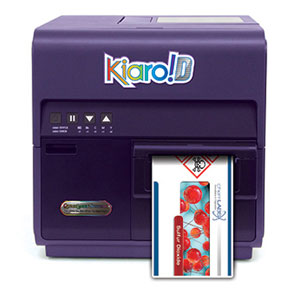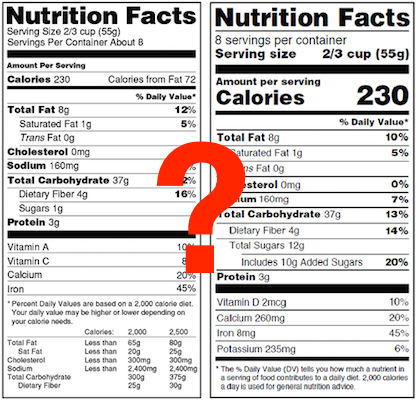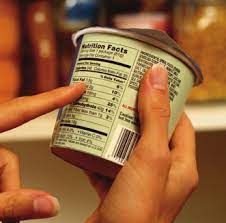How to Print Nutrition Labels
We get a lot of questions about printing food labels here at ReciPal. Usually the question is whether we do that for you. Unfortunately, we don't, but we'll try to help in this article.
The reason we don't is that printing is a whole separate business and there are so many options that we couldn't do them all well. But we want to help as much as we can with getting your food product packaged and labeled as you start and grow your food business. So here's some information and a few possible resources on how to print nutrition labels.
Labels or Pre-Printed Packaging?
The point of labeling is to provide both required and marketing information to consumers. You can accomplish those goals either by printing on a separate label (or two) and affixing it to your package or by printing directly onto your package. The first method gives you a broader range of options with respect to quality, turnaround, and price. The second requires professional packagers with the right printing equipment - and while it can be cheaper on a per package basis you need to do rather large printing runs to make it worthwhile.
Options For Printing Labels
Just Starting Out - Use What You've Got
You can use the printer you have and make your own labels using readily available commercial products and templates like ones from Avery. Using this approach you don't incur any investment costs (unless you don't have a printer), and you can make the labels as you need them, which also allows you to control costs.
But using what you have can compromise the professional look of your product. Home printers can handle only limited colors, limited resolution, and they provide inconsistent results in the color output. Standard labels aren't necessarily durable enough to withstand a lot of handling, but there is a variety of options for label types that are more durable, freezer friendly, and more.
Also, ink or toner cartridges run out quickly, so the expenses can add up once the number of labels you need passes a certain point. And making the labels can become time consuming since standard printers don't work that fast, and you have to monitor your results and toner levels and take care of loading paper. Factoring in ink and your time, printing on your home printer can surprisingly be one of the most expensive options. For test and samples it is a great option to quickly get your packaging together.
You can address some of these issues, like quality and time, by using an online print service where you can upload your label design or use one of their templates and order the number of labels you need.
Resources for labeling with your existing printer:
To buy labels and get templates for your own regular printer, you can look at the following:
- Online Labels sells labels, offers templates, and even has a custom printing service. The website is easy to navigate, so finding what you need is not a problem.
- Another option for supplies, templates, and printing software is World Label
For online printing, you can check out sites like U Printing, Print Runner, and YouPrint Labels. For more custom labels, you can also try Presto Labels.
Next Stage - Work With A Pro
Another option, especially as your business grows, is to outsource your labels to a full-service printer. The pros of using the pros (we couldn't help ourselves!) include: high quality, greater design and style options, and durable materials. And, of course, you free your time for other aspects of your business.
On the other hand, outsourcing can be pricey, and you become dependent on the printer and have to think about lead times. Small print runs are expensive because of the set-up costs. Prices decrease with volume, but the levels you need to reach before seeing cost benefits are generally in the tens of thousands. You will also be relying on a vendor and their ability to meet deadlines, so you need to build a good relationship with a printer who will get your job done and have your back when the unexpected happens.
There are many options, from online outfits to local offices, from support for doing part of the work yourself to full-service shops. And there are different printing processes, usually digital or flexographic. (For an explanation of the differences between the two you can see this blog post at Valley Forge Tape and Label or this presentation from LabelValue.) Making the right choices involves research and due diligence.
Resources for outsourcing labels:
- Places like Lightning Labels or Blue Label offer digital printing. Charges vary depending on materials, quantities, label size, and versions. You can count on a minimum of $225 for one version of 50 labels at Lightning. Blue Label has a stated minimum charge of $200 with the number of labels you get for that varying depending on other choices.
- Richmark Label is located in Seattle but works nationally and offers both digital and flexographic printing.
- In Los Angeles or the Western US, The Label Company offers various services (including label compliance).
- Other places to look online include Inland Packaging, Tenka, and Consolidated Label.
- Find local printers by asking other people (in the food industry or not) who they use and meeting representatives in person.
Capital Investment - Buy a Label Printer

A label printer, like this one from QuickLabel, gives great results.
Buying a printer designed specifically for labels is another option that combines doing it yourself with more professional-looking outputs. Even in the early stages of your business, you can buy a smaller label printer to get the professional look while maintaining control over your process. And once your business grows to a certain point, you might find it's time to bring all your operations in house and invest in a labeling system.
Label printers and systems vary widely based on size, color, resolution, and capacity, from the compact desktop to the industrial work horse. Costs also vary widely, from the hundreds to the high thousands and more, and include the upfront capital investment in the printer as well the labor that you're back to providing. But you gain a level of control over your costs, quality, and inventory, including not having to consider the lead time you need to give to a print shop.
The rule of thumb is generally that it will be cheaper to outsource the job if you're printing about 5,000-10,000 labels of the same style - below that you want to consider doing your own. So if you're doing smaller runs, have a wide variety of products, or are constantly testing new labels and products, this is a great option. Alongside a label printer you can combine all manners of equipment to automate the process - cutters, rewinders, applicators.
Resources:
- The only label printers we can truly recommend are from Quick Label. These are very high quality and fast label printers with simple software that works seamlessly with ReciPal and makes it easy to combine with a barcode, add your logo, and any marketing materials you want. They have great customer service to help you pick out the right labels, additional equipment, and walk you through the process.
- We've had quite a few customers using Rollo Printers and having a great experience too. They have a very affordable thermal printer and sell labels as well, so it's a bit of a one stop shop.
- Label Value sells printers and supplies. The company also offers lots of information on making labels and provides a service for making custom food labels.
- Weber Labels sells labeling systems and also offers graphic design services. Met Speed Label sells printers and systems to small and medium food manufacturers in addition to their primary custom printing services. And Fernqvist Labeling Solutions also sells printers and supplies and offers custom labels.
- For full color printers, look at Afinia Label, Primera Technology, and Epson.
- For information on choosing printers and to look at printers and label supplies you can check out FoodSoftware
Printed Packaging
If you forego the stick-on label completely and incorporate your information into your packaging, you don't have to worry about the durability of the label. Since the information is printed directly onto the paper or cardboard or plastic film or fused onto a plastic container, you'll need an outside vendor for the process.
While really elaborate printed packaging is high end, there are options for certain products that don't have to break your budget. You can print directly on paper or plastic bags, for example, using online shops that offer stock supplies and custom printing services. In the long run, pre-printed packaging is one of the cheapest options on a per unit basis and looks fantastic - but you have to print thousands at a time and invest serious capital to make it worthwhile.
Resources:
- For a case study of changing packaging and using direct print, you can look at this project done by Stronghaven.
- The BoxMaker, located in Seattle, can digitally print packaging. They print custom labels and do a host of other things too.
- PBFY offers a variety of printing solutions for bags (hot stamp, labels, custom printing) and a decent comparison of the types and uses.
- Pacific Bag and Roastar are two other options for paper or foil bags.
- For plastic food bags, you can look at Clear View Bag Company or Flexo.
Other Resources
In case you want to know more about the lingo of labels and printing, ID Images has a nice glossary. For specific and really helpful advice based on personal experience, Michael Adams' of Green Mountain Mustard (and Gredio) has a great post on how to print food labels. And please share your tips, ideas, or thoughts on printing labels and any recommendations for vendors or services in the comments below.






